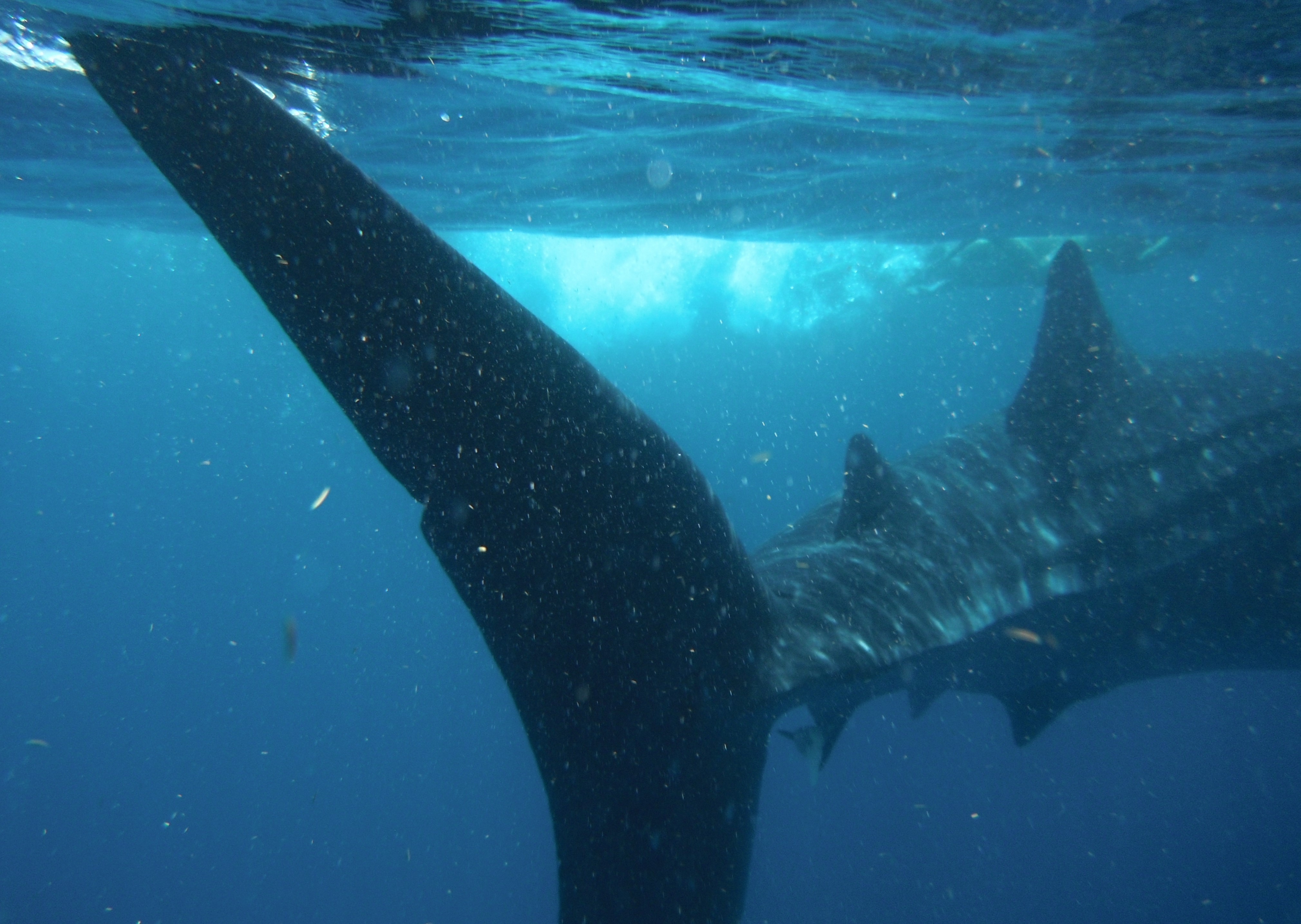Where to Swim With Whale Sharks Ultimate Travel Guide
I’m on a boat bobbing up in down in the blue expanse of the Caribbean Sea. A sucking sound off the starboard side, like water draining in a bathtub catches my attention. The speckled blob of a whale shark moves past the boat slowly, mouth open wide.
Another one approaches, and I swing my legs over the side and jump in. Moving clumsily through the water, the beast to my right glides smoothly past, ignoring my feeble efforts to keep up. As it moves off into the deep blue, another approaches, and I turn to admire the star-like pattern down the length of its body.
Luckily, these creatures have no interest us, but our fascination with them is epic. As the largest fish in the oceans, the size of a whale shark can be intimidating, but their grace is pure beauty. To see a whale shark is one thing, but to swim next them is a dream come true.
Disclosure: Some links may be affiliate links where we receive a super-small commission at no additional cost to you if you click through and make a purchase. We call this our Chocolate & Churro Fund.

Whale Shark Tour in the Yucatan
Between June and August, an influx of plankton and spawning coral and fish lures the whale sharks up the Yucatan for an unparalleled feast. At 25-40 feet in length, the whale shark dwarfs all other fish species in the oceans yet eats the smallest animals in the food chain. Their mystical spotted and striped patterns are unique to each individual just like our fingerprints.
My whale shark tour was run by EcoColors, a tourism company working with several organizations to preserve our natural and cultural world. The tour included pick up from my hotel, a small continental breakfast buffet and a rundown on whale shark biology and rules on how to interact with the whale sharks:
- Two people and a guide would go into the water at a time.
- Jump in slightly in front of the whale shark, then turn and swim beside them.
- Don’t touch them.
- Watch out for the tail.
- Don’t touch them.
- Stay to the side and don’t swim above or below the whale shark.
- Don’t touch them.
They were very strict on the no-touching policy.
Whale Shark Encounter
A 45-minute boat ride into the middle of nowhere, and our first sighting was not of whale sharks, but of other tour boats.
As we got closer, we could see dorsal fins pierce the surface and I watched people swim awkwardly in their life jackets after the whale sharks. Before I even had a chance to get my wetsuit on, a whale shark swam right up next to the boat, its mouth wide open. The tip of its upper lip could be seen just above the water.
Three times I went into the water, each time different than the last. The gentle giants moved in a slow ballet while feeding on the smallest creatures of the sea. Each time we were close to the tail of one we turned, and another whale shark would be heading towards us.
Because of the plankton, water visibility wasn’t the best until we were right beside one of the 25-foot-long goliaths. The spots on the whale shark shown like stars. I watched in awe as they would open their mouths and filter the water through their huge gaping gills. The fluid movement of their tails was a slow gentle swish, but enough force behind it to make it hard to keep up.
What Do We Know About Whale Sharks?
We have so many questions that are still unknown about whale sharks. Scientists around the globe want to know how to accurately predict their numbers, understand their biology, feeding and migratory behavior, nursery locations, and how better to focus their conservation efforts.
How can you tell the difference between a male and female whale shark?
Male whale sharks can easily be identified because they have claspers, the male reproductive organs located between the belly and the tail, females do not. Scientists believe whale sharks do not reach sexual maturity until they reach 8 meters (26 feet) or more in length, around the age of 25 years. We know that whale sharks give live birth, but their mating behavior and gestation time are still unknown.
The majority of the whale shark population feeding off the Yucatan coast of Isla Mujeres and Holbox are males. So where are the females hanging out, and where do whale sharks go for 6 months out of the year?
Tagging efforts have given us a little more information, and we know the Caribbean whale sharks head out into the Atlantic.
Whale sharks are found in tropical and warm temperate waters.
Amazingly, you can find them from New York to Brazil, California to Chile, Japan to Australia, and off the coasts of the Red Sea, Arabian Gulf, Africa, and India. They are a pelagic (open ocean) species and spotting them is extremely difficult. The best times to observe whale sharks are during plankton blooms.
Things We Do Know About Whale Sharks
Whale sharks are slow swimmers which make them easy to interact with. They do have rows of teeth about 2-6 mm in size, but they are filter feeders sucking in plankton and krill and then expelling the water through their gills.
Whale sharks can be grey, blue or brownish with a white belly and creamy white spots. The spot pattern above the pectoral fin and personal scars are used to identify individual whale sharks.
Things We Don’t Know About Whale Sharks
Researchers are still doing a lot of guesswork about whale sharks. No one has ever seen a whale shark giving birth or knows how long they live (some resources say 60 years, others say 100). Usually divers encounter juvenile whale sharks about 15-25 feet long, but there have been reports of whale sharks reaching 40 feet.
We do know that they are ovoviviparous, which means that the female has egg cases in her uterus but gives birth to live young. How many? The professional guess is around 300. Females can store sperm and fertilize their own eggs as evidenced by the different stages of development found in a female whale shark that was captured off of Taiwan in 1995.
Only recently, whale shark mating activity has been sighted and recorded. You can read about it on Livescience.com: Attempted Whale Shark Mating Caught on Camera for the First Time in History.
Tourism and Whale Sharks
Swimming with whale sharks has become a lucrative business for local fisherman and conservation tours not only in Mexico, but around the world. Striking the right balance between educating the public, providing locals with a source of revenue and protecting the species is something scientists, conservationists and the tourism industry are working hard to find the right balance.
It’s only recently that we’ve been able to track some of their migrations and establish protected waters for their seasonal feeding grounds.
List of Where to See Whale Sharks Around the World:
CARIBBEAN
The Caribbean Sea is probably one of the best locations in the world. Animal lovers have many chances to see the whale sharks as they move up the coastline following the influx of plankton. They are spotted year-round off of Honduras especially Utila, but the best time is February through April. Belize is their next stop in April and May and also in September. June, July and August they can be found off the Yucatan Peninsula around Holbox Island (an hour from Cancun). Plankton blooms are especially prominent during the full moon.
Travel Tip: You can scuba dive with whale sharks in Honduras and Belize, but not in Mexico.
MEXICO
Whale sharks can be found off the Yucatan and Baja California. November through May you can spot them off of Cabo San Lucas, La Paz and other areas in the Sea of Cortez. This area is popular for juvenile whale sharks. June through September is the best time to see them off of Isla Holbox, Isla Mujeres and Cozumel near Cancun.
THAILAND
Thailand’s Similan Islands in the Andaman Sea whale shark season is February through April.
PHILIPPINES
November through June is the best time to see whale sharks in the Philippines.
WESTERN AUSTRALIA
Central Western Australia’s Ningaloo Reef is probably the best known for whale sharks. Their season is from April to July.
MALDIVES
The Maldives in the Indian Ocean has two seasons to see whale sharks; they can be seen off the east coast during the southwest monsoon (June through September), and off the west coast during the northeast monsoon (January to March).
Travel Tip: June through September is the wet season and seas can be rough.
Today, whale sharks are listed as a vulnerable species by the International Union for Conservation of Nature and Natural Resources (IUCN). They are hunted for their fins and meat in Hong Kong, India, and other Asian countries.
Taiwan was discovered to be a birthing ground in the summer for whale sharks, and in 2008, Taiwan banned the fishing and sale of whale shark meat.

WHALE SHARK RESEARCH PROGRAMS
Many whale shark research programs have been established around the world. Hubbs- Sea World Research Institute has tagged several whale sharks with radio telemetry since 1994. Whale shark research projects include obtaining genetic information, surveying environments and tracking whale sharks using satellite tags and photo identification.
Noteworthy conservation programs include the Maldives Whale Shark Research Programme, Whale Shark Conservation in Thailand, and Utila Whale Shark Research organized by the dive company Deep Blue Utila.
Several of these projects are collaborations between universities, government organizations and non-profit organizations such as World Wildlife Fund and The Nature Conservancy.
Why I chose EcoColors Mexico
EcoColors is actively working to ensure the preservation of our destination and culture for future generations. This equates to more attractive environments and better products. We are currently working with different NGO´s such as the Mexican Association of Adventure travel and ecotourism, World Wildlife Fund, The Nature Conservancy, Conservation International, Travel Foundation, Amigos de Sian Kaan, The Coral Reef Alliance and many more in unique training programs on ecotourism, development of best practices, code of ethics and many important actions to achieve or get closer to a sustainable tourism practice.
What to Bring When Swimming With Whale Sharks
For this trip, I did not bring my large Canon camera with the telephoto lens. The boat travels fast and water spray is very common.
Whether it’s sunny or foggy I recommend these items to make your trip more enjoyable:
- Bathing Suit
- Rash Guard
- Sunglasses
- Seasickness wristbands
- water/snacks
- socks
- waterproof bag
- waterproof shoes or all-terrain sandals
- windbreaker
- Waterproof camera: GoPro with underwater housing case
***Try not to wear sunscreen. The sunscreen is creating a film that is suffocating the reefs. Wear a rash guard, wetsuit, or other type of cover-up.
WHALE SHARK FESTIVALS
Celebrations for whale shark enthusiasts are happening around the globe as well. Ningaloo Whale Shark Festival takes place in May, and Isla Mujeres parties for an entire week in July. If you plan to see whale sharks, these are optimal times to see them in these areas.
Wherever your quest for whale sharks may take you, enjoy a unique and safe encounter with these gentle giants. To be able to safely interact with the largest fish in the sea is an unforgettable experience.
Pin This!
Here’s some other great adventure to do while you are in the Yucatan:














This must have been something else. I loved your video, so cool. I learned so much too, I frankly knew nothing about them before. They are quite the enigma.
I’m glad that I could offer useful information to understand them better to you and maybe a few others out there!
Cool whales sharks! I’ve swim with reef sharks but they were a lot smaller. Interesting that they’re such an enigma and comforting to know that the feed on plankton because they’re huge!
They are huge, but so graceful!
What big, beautiful and graceful beings. Didn’t know you were on youtube too, so we jumped over and subscribed!
B
Thank you, Bernie and Jess!
Who knew there were whale shark festivals?
Just another reason to party!
wow! it sounds like an incredible experience! I had no idea about whale sharks before your post. key lesson learned: don’t touch them. and, apparently there are whale shark festivals. how interesting! thanks for sharing! 🙂
I’m glad I could shed some light on some remarkable creatures of the sea!
I read this with interest as we hope to swim with them in Exmouth on the Ningaloo Reef. How sad that they are hunted for their fins and meat, makes me so angry. Our daughters are studying marine biology at school and get to swim with whale sharks on their last year!